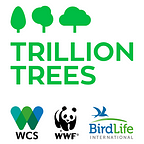INVESTING IN RESTORATION
Restoring forests takes much more than the act of planting a tree: and costs more.
By John Lotspeich, Executive Director, Trillion Trees
Trees have become a widely-accepted — dare I say, even a reserve — currency in resourcing the fight against climate change.
Droughts, extreme weather, rising temperatures are here; as is a crash in our planet’s biodiversity, with millions of species at risk — which in turn threatens the world’s food security.
And there’s equal certainty that forests are a central piece of how we have to respond if we have any hope of saving the planet[1],[2],[3].
But trees aren’t forests, and its forests that help deliver climate, biodiversity and even human stability. Over the past few years, we’ve witnessed the explosion of tree planting initiatives, many putting their stake in the ground at “$1 per tree”, or even less, and funding has flooded in from philanthropic private donors, individuals and businesses, alongside rapid growth in corporate involvement.
This is all great news. But creating a public perception that forest restoration — which is what we actually need — can be achieved for very little cost risks undermining the success of a burgeoning and promising restoration movement.
A focus on tree numbers can create pressure to overlook the investment needed to work collaboratively and effectively with local communities; to source the right trees for the right places and crucially, to maintain these restoration sites to ensure long-term growth and survival. Tree-counts alone as metrics can make it easier to avoid the hard work needed to establish financial mechanisms to keep these efforts — and usually end up being funded by short term donor cycles.
Under-budgeted projects are more likely to fail, leading to an overestimate of the area restored[4], missing important climate targets and significant amount of money wasted. It is important that claims about the benefits of planting trees can be substantiated, and that investments are delivering sustainable results.
Tree planting is an essential part of the process, but it is not the only thing that needs to happen when we set out to restore forests. This is why we just published a brief about addressing the urgent need for better cost estimates and are undertaking research to establish a realistic calculation of the investment needed to deliver high-quality sustainable forest restoration, grounded in globally-accepted forest and landscape restoration principles.
Our approach is simple: we’ve defined five considerations for effectively costing forest restoration, with the aim of ensuring project budgets better reflect the true costs and resources needed by projects and organisations to implement good practice — and this is the crucial part — therefore, resulting in better estimates of impact and better outcomes.
Why do this now? Until recently, with the introduction of a framework by The Economics of Ecosystem Restoration (TEER), a UN Decade on Ecosystem Restoration initiative, there hasn’t been a consistent approach to assessing costs (or benefits) of ecosystem restoration.[4]
Understanding the true cost of successful forest restoration is critical to arrive at a global recognition of the investment needed to ensure efforts are long-term, sustainable, and meaningfully contribute to achieving the ambitions of the Paris and Glasgow Agreements. Restoration of natural ecosystems is an ongoing and long-term commitment, requiring accurate estimations of key programme variables over multiple year and even decade scenarios.
Feeding into TEER, we are gathering data from our forest conservation programmes to bolster the case for comprehensive restoration costing as opposed to costing simply for straight-up tree-planting.
For donors, corporates and philanthropists, we hope we can make the case for these considerations to be included in any costing exercise, wherever restoration is considered.
Finally, this work aims to support and endorse the global trend towards more accountability and transparency for the resources invested in tree-planting and forest restoration programmes, which we believe will be vital to bringing in the additional private-sector investments that will be needed if we are to have any hope of achieving our climate goals.
‘Defining the Real Cost of Restoring Forests,’ a Trillion Trees white paper can be downloaded here.
[1] https://www.ipcc.ch/report/ar6/wg1/
[2] https://www.ipcc.ch/report/ar6/wg2/
[3] https://www.ipcc.ch/report/ar6/wg3/
[4] Bodin, B., Garavaglia, V., Pingault, N., Ding, H., Wilson, S., Meybeck, A., … & Besacier, C. (2021) A standard framework for assessing the costs and benefits of restoration: introducing The Economics of Ecosystem Restoration (TEER). Restoration Ecology, e13515.
